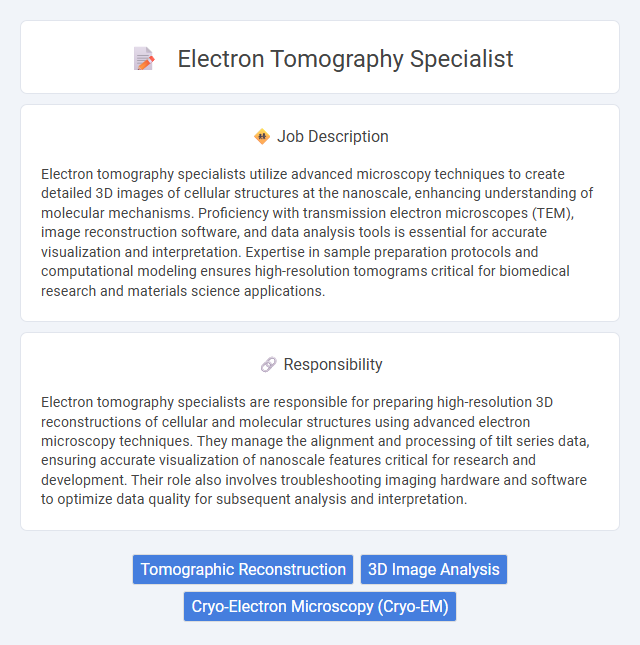
Electron tomography specialists utilize advanced microscopy techniques to create detailed 3D images of cellular structures at the nanoscale, enhancing understanding of molecular mechanisms. Proficiency with transmission electron microscopes (TEM), image reconstruction software, and data analysis tools is essential for accurate visualization and interpretation. Expertise in sample preparation protocols and computational modeling ensures high-resolution tomograms critical for biomedical research and materials science applications.
Individuals with strong analytical skills and a keen interest in nanoscale imaging are likely suitable for a role as an Electron Tomography Specialist. Those who are comfortable working in highly technical environments and have patience for meticulous data analysis may find this job particularly rewarding. It is probable that candidates who thrive in precise, detail-oriented tasks and possess a background in electron microscopy or materials science will excel in this position.
Qualification
An Electron Tomography Specialist must possess advanced expertise in transmission electron microscopy (TEM) and three-dimensional imaging techniques, often requiring a master's or doctoral degree in materials science, physics, or related fields. Proficiency in operating electron microscopes, data acquisition software, and image reconstruction algorithms is essential for accurate tomogram generation and interpretation. Strong analytical skills, attention to detail, and experience with visualization tools like IMOD or Amira enhance the specialist's ability to deliver precise structural insights at the nanoscale.
Responsibility
Electron tomography specialists are responsible for preparing high-resolution 3D reconstructions of cellular and molecular structures using advanced electron microscopy techniques. They manage the alignment and processing of tilt series data, ensuring accurate visualization of nanoscale features critical for research and development. Their role also involves troubleshooting imaging hardware and software to optimize data quality for subsequent analysis and interpretation.
Benefit
Electron tomography specialists likely gain access to cutting-edge imaging technologies that enhance their expertise in 3D structural analysis. They probably experience career growth opportunities in research institutions and high-tech industries due to the increasing demand for nanoscale visualization. The role may provide a collaborative environment with interdisciplinary teams, fostering innovation and skill development.
Challenge
Electron tomography specialists likely face the challenge of managing and interpreting large, complex datasets generated from high-resolution 3D imaging, requiring advanced skills in data processing and visualization. The probability of encountering technical difficulties with specimen preparation and imaging conditions may demand innovative problem-solving and adaptability. Rapid advancements in microscopy technology could also necessitate continuous learning to stay current with evolving methodologies.
Career Advancement
Electron tomography specialists gain expertise in 3D imaging techniques to reconstruct cellular structures at nanometer resolution, enhancing their value in research institutions and biotech companies. Mastery of advanced electron microscopy software and data analysis tools opens pathways to lead multidisciplinary projects or transition into senior scientist roles. Continuous professional development through workshops and certification accelerates career progression within academia or the pharmaceutical industry.
Key Terms
Tomographic Reconstruction
Electron tomography specialists expertly perform tomographic reconstruction to generate high-resolution 3D images from 2D electron microscopy data. They apply advanced algorithms and software tools to accurately reconstruct cellular structures at the nanoscale, enabling detailed visualization of biological and material samples. Proficiency in image processing, computational modeling, and data interpretation is essential for optimizing reconstruction quality and resolving complex specimens.
3D Image Analysis
Electron tomography specialists apply advanced 3D image analysis techniques to reconstruct high-resolution, three-dimensional models of cellular structures from electron microscopy data. Expertise in image segmentation, volume rendering, and quantitative morphometric analysis is essential to extract meaningful biological insights from complex tomograms. Proficiency with software tools such as IMOD, Amira, or Chimera enables precise visualization and interpretation of nanoscale architectures critical for research in structural biology and materials science.
Cryo-Electron Microscopy (Cryo-EM)
Electron tomography specialists in Cryo-Electron Microscopy (Cryo-EM) expertly prepare cryogenically preserved biological samples and acquire tilt-series images to generate high-resolution 3D reconstructions of macromolecular structures. Proficient in image processing software such as IMOD and RELION, these specialists analyze structural data critical for understanding protein complexes and cellular architecture. Their expertise supports advancements in structural biology, drug design, and molecular medicine by providing detailed visualization at near-atomic resolution.
 kuljobs.com
kuljobs.com